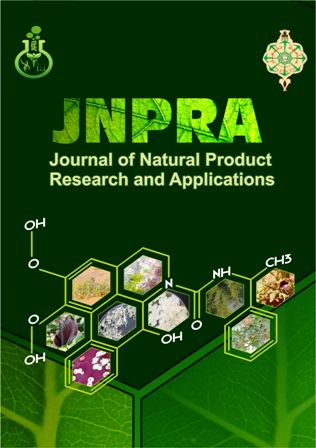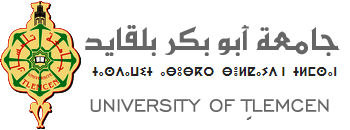Antimicrobial activity of Tetraclinis articulata aerial parts essential oil from Tlemcen, Northwestern of Algeria
DOI:
https://doi.org/10.46325/jnpra.v1i03.26Keywords:
Tetraclinis articulata (Vahl) Masters (Barbary Thuya); essential oil composition; chemical variability; antimicrobial activity, AlgeriaAbstract
The essential oil from aerial parts of Tetraclinis articulata (Vahl) Masters, obtained by
hydrodistillation was analyzed by GC, GC/MS and 13C-NMR and evaluated for antimicrobial
activity. The essential oil was rich in monoterpenes which α-pinene, bornyl acetate and
camphor being the main constituents.Three essential oils were tested against Staphylococcus
aureus, Enterococcus faecalis, Pseudomonas aeruginosa, Escherichia coli, Klebsiella
pneumoniae, Candida albicans, Aspergillus fumigatus and Aspergillus flavus and the
minimum inhibitory concentration was determined.The tested oils have been shown to
possess inhibitory action in the range from 1 to 6 µL/mL against Aspergillus fumigatus, A.
niger and Staphylococcus aureus. However, essential oil with camphor as major component
was the most interesting, with CMIs ranging between 1 and 3 µL/mL. While, essential oil
with α-pinene as major compound, remains the less effective, with CMIs ranging between 2
and 6 µL/mL.
References
Abi-Ayad, F.Z., Abi-Ayad, M., Lazouni, H.A., Rebiahi, S.A., & Bessiere. (2011). Antibacterial activity of essential oil extracted from leaves of Tetraclinis articulata (Vahl) Masters from Algeria flora. Journal of Microbiology Biotechnology Research, 1, 1–6.
Abi-Ayad, F.Z., Abi-Ayad, M., Lazouni, H.A., & Rebiahi, S.A. (2013). Evaluation of Tetraclinis articulata essential oil from Algeria flora as a potential source of antifungal activity and study of its chemical composition. Indian Academy of Wood Science, 10, 9–15.
Achak, N., Romane, A., Alifriqui, M., & Markouk, M. (2009). Chemical composition, organic and mineral contents of leaves of Tetraclinis articulata (Vahl) Masters from the Tensift-Al Haouz, Marrakech region (Morocco). Journal of Essential Oil Bearing Plants, 12, 198–204.
Aouinty, B., Oufara, S., Mellouki, F., & Mahari, S. (2006). Évaluation préliminaire de l’activité larvicide des extraits aqueux des feuilles du ricin (Ricinus communis L.) et du bois de thuya (Tetraclinis articulata (Vahl) Mast.) sur les larves de quatre moustiques culicidés: Culex pipiens (Linné), Aedescaspius (Pallas), Culiseta longiareolata (Aitken) et Anopheles maculipennis (Meigen). Biotechnology. Agronomy, Society and Environment, 10, 67–71.
Barrero, A.F., Herrador, M.M., Arteaga, P., Quilez, J., Akssira, M., Mellouki, F., & Akkad, S. (2005). Chemical composition of the essential oils of leaves and wood of Tetraclinis articulata (Vahl) Masters. Journal of Essential Oil Research, 17, 166–168.
Bellakhdar, J., Honda, G., & Miki, W. (1982). Herb–Drugs and Herbalists in the Maghrib. Institute of the Study of Languages and Cultures of Asia and Africa, Tokyo.
Ben Jemia, M., Chaabane, S., Senatore, F., Bruno, M., & Kchouk, M.E. (2013). Studies on the antioxidant activity of the essential oil and extract of Tunisian Tetraclinis articulata (Vahl) Mast. (Cupressaceae). Natural Product Research, 27, 1419–30.
Ben Ghnaya A., Amri I., Hanana M., Gargouri S., Jamoussi B., Romane A., & Hamrouni L. (2016). Tetraclinis articulata (Vahl.) Masters essential oil from Tunisia: Chemical characterization and herbicidal and antifungal activities assessment. Industrial Crops and Products, 83, 113–117.
Bourkhiss, B., Ouhssine, M., Hnach, M., Bourkhiss, M., Satrani, B., & Farah, A. (2007a). Composition chimique et bioactivité de l’huile essentielle des rameaux de Tetraclinis articulata. Bulletin de la Société de Pharmacie de Bordeaux, 146, 75–84.
Bourkhiss, M., Hnach, M., Bourkhiss, B., Ouhssine, M., & Chaouch, A. (2007b). Composition chimique et propriétés antimicrobiennes de l’huile essentielle extraite des feuilles de Tetraclinis articulata (Vahl) du Maroc. Afrique Science, 03, 232–242.
Bourkhiss, M., Hnach, M., Paolini, J., Costa, J., Farah, A., & Satrani, B. (2010). Propriétés antioxydantes et anti-inflammatoires des huiles essentielles des différentes parties de Tetraclinis articulata (Vahl) Masters du Maroc. Bulletin de la Société Royale des Sciences de Liège, 79, 141–154.
Boussaïd, M., Bekhechi, C., Beddou, F., Chabane Sari, D., Bighelli, A., Casanova, J., & Tomi, F. (2015). Chemical variability of the essential oil isolated from aerial parts of Tetraclinis articulata from North-Western Algeria. Natural Product Communications, 10, 1447–1452.
Buhagiar, J.A., Podesta, M.T.C., Wilson, A.P., Micallef, M.J., & Ali, S. (1999). The induction of apoptosis in human melanoma, breast and ovarian cancer cell lines using an essential oil extract from the conifer Tetraclinis articulata. Anticancer Research, 19, 5435–5443.
Burt, S. (2004). Essential oils: their antibacterial properties and potential applications in foods– a review. International Journal of Food Microbiology, 94, 223–253.
Chang, S.T., Chen, P.F., & Chang, S.C. (2001). Antimicrobial activity of leaf essential oil and their constituants from Cinnamomum osmophloeum. Journal of Ethnopharmacology, 77, 123–127.
Chikhoune, A., Hazzit, M., Kerbouche, L., Baaliouamer, A., & Aissat, K. (2013). Tetraclinis articulata (Vahl) Masters essential oils: Chemical composition and biological activities. Journal of Essential Oil Research, 25, 300–307.
Daferera, D.J., Ziogas, B.N., & Polissiou, M.G. (2003). The effectiveness of plant essential oil on the growth of Botrytis cinera, Fusarium sp. and Clavibacter michiganensis. Journal of Crops and Protucts, 22, 39–44.
Dai, J., Zhu, L., Yang, L., & Qiu, J. (2013). Chemical composition, antioxydant and antimicrobial activities of essential oil from Wedelia prostrata. Journal of Experimental and Clinical Science, 12, 479–490.
Djouahri, A., Boudarene, L., & Meklati, B.Y. (2013). Effect of extraction method on chemical composition, antioxidant and anti-inflammatory activities of essential oil from the leaves of Algerian Tetraclinis articulata (Vahl) Masters. Industrial Crops and Products, 44, 32–36.
Djouahri, A., Boualem, S., Boudarene, L., & Baaliouamer, A. (2015). Geographic’s variation impact on chemical composition, antioxidant and anti-inflammatory activities of essential oils from wood and leaves of Tetraclinis articulata (Vahl) Masters. Industrial Crops and Products, 63, 138–146.
Djouahri, A., Sebiane, S., Kellou, F., Lamari, L., Sabaou, N., Baaliouamer, A., & Boudarene, L. (2016). Inhibitory effect on corrosion of carbon steel in acidic media, antioxidant, antimicrobial, anti-5- lipooxygenase and anti-xanthine oxidase activities of essential oil from Tetraclinis articulata (Vahl) Masters leaves. Journal of Essential Oil Research, 1–9.
Dorman, H.J.D., & Deans, S.G. (2000). Antimicrobial agents from plants: antibacterial activity of plant volatile oils. Journal of Applied Microbiology, 88, 308–316.
Duke, J.A., & Beckstrom-Strenberg, S.M. (2001). Handbook of medicinal mints (aromathematics) phytochemicals and biological activities. Edition CRC Press, Boca Raton.
Erdoğan Orhan, İ., Ozcelik, B., Kartal, M., & Kan, Y. (2012). Antimicrobial and antiviral effects of essential oils from selected Umbelliferae and Labiatae plants and individual essential oil components. Turkish Journal of Biology, 36, 239–246.
Ibrahim, T., El-Helac, A., El-Hefnawy, H., Al-Taweel, A., & Perveena, S. (2017). Chemical Composition and Antimicrobial Activities of Essential Oils of Some Coniferous Plants
Cultivated in Egypt. Iranian Journal of Pharmaceutical Research, 16, 328–337.
Jung, E.K. (2009). Chemical Composition and Antimicrobial Activity of the Essential Oil of Chrysanthemum indicum against Oral Bacteria. Journal of Bacteriology and Virology, 39, 61–69.
Knobloch, K., Pauli, A., Iberl, B., Weigand, H., & Weis, N. (1989). Antibacterial and antifungal properties of essential oil components. Journal of Essential Oil Research, 1, 119–128.
Lahlou, M. (2004). Methods to study phytochemistry and bioactivity of essential oils. Phytotherapy Research, 18, 435–448.
Leite, A.M., Lima, E.O., EL Souza, Diniz M.F.F.M., Trajano, V.N., & Medeiros, I.A. (2007) Inhibitory effect of β-pinene, α-pinene and eugenol on the growth of potential infectious endocarditis causing Gram-positive bacteria. Brazilian Journal of Pharmaceutical Sciences, 43, 121–126.
Lemos, M.F., Lemos, M.F., Pacheco, H.P., Endringer, D.C., & Scherer, R. (2015). Seasonality modifies rosemary’s composition and biological activity. Industrial Crops and Products, 70, 41–47.
Magiatis, P., Skaltsounis, A.L., Chinou, I., & Haroutounian, S.A. (2002). Chemical Composition and in-vitro Antimicrobial Activity of the Essential Oils of Three Greek Achillea Species. Zeitschrift für Naturforschung, 57c, 287–290.
NCCLS (National Committee for Clinical Laboratory Standards) (2001). Performance standards for antimicrobial susceptibility testing: eleventh informational supplement. NCCLS document M100- S11. USA: Villanova, 21(1).
Ouattara, Z.A., Boti, J.B., Ahibo, A.C., Sutour, S., Casanova, J., Tomi, F., & Bighelli, A. (2014). The key role of 13C NMR analysis in the identification of individual components of Polyalthia longifolia leaf oil. Flavour Fragrance Journal, 29, 371–379.
Preuss, H.G, Echard, B., Enig, M., Brook, I., & Elliot, T.B. (2005). Minimum inhibitory concentrations of herbal essential oils and monolaurin for Gram-positive and Gram-negative bacteria. Molecular and Cellular Biochemistry, 272, 29–34.
Quèzel, P., & Santa, S. (1962). Nouvelle flore de l’Algérie et des régions désertiques méridionales. Edition CNRS, Tome II, Paris, 34.
Quèzel, P., & Médail, F. (2003). Ecologie et biogéographie des forêts du bassin méditerranéen. Editions Technique et Documentation, Lavoisier, 125.
Rabib, H., Zougagh S., Hssain, M., Badri, W., & Koussa, T. (2019). GC/MS and Antibacterial Activity of the Essential Oil of Moroccan Tetraclinis articulata (Vahl) Masters. Mediterranean Journal of Chemistry, 8, 302–307.
Rabib, H., Elagdi, C., Hsaine, M., Fougrach, H., Koussa, T., & Badri, W. (2020). Antioxidant and Antibacterial Activities of the Essential Oil of Moroccan Tetraclinis articulata (Vahl) Masters. Biochemistry Research International, 1–6.
Rather, M.A., Dar, B.A., Dar, M.Y., Wani, B.A., Shah, W.A., Bhat, B.A., Ganai, B.A., Bhat, K.A., Anand, R., & Qurishi, M.A. (2012). Chemical composition, antioxidant and antibacterial activities of the leaf essential oil of Juglans regia L. and its constituents. Phytomedicine, 19, 1185–1190.
Runyoro, D., Ngassapa, O., Vagionas, K., Aligiannis, N., Graikou, K., & Chinou, I. (2010). Chemical composition and antimicrobial activity of the essential oils of four Ocimum species growing in Tanzania. Food Chemistry, 119, 311–316.
Skaltsa, H.D., Demetzos, C., Lazari, D., & Sokovic, M. (2003). Essential oil analysis and antimicrobial activity of eight Stachys species from Greece. Phytochemistry, 64, 743–752.
Sonboli, A., Babakhani, B., & Mehrabian, A.R. (2006). Antimicrobial Activity of Six Constituents of Essential Oil from Salvia. Zeitschrift für Naturforschung, 61c, 160–164.
Tabanca, N., Kirimer, N., Demirci, F., & Baser, K.H. (2001). Composition and antimicrobial activity of the essential oils of Micromeria cristana subsp. phrygia and the enantiomeric distribution of borneol. Journal of Agricultural and Food Chemistry, 49, 4300–4303.
Tomi, F., Bradesi, P., Bighelli, A. & Casanova, J. (1995). Computer-aided identification of individual components of essential oils using Carbon-13 NMR spectroscopy. Journal of Magnetic Resonance Analysis, 1, 25–34.
Tomi, F., & Casanova, J. (2006). 13C-NMR as a tool for identification of individual components of essential oils from Labiatae. A review’, In “The Labiatae: Advances in Production, Biotechnology and Utilization” Eds: Cervelli, C., Ruffoni, B., Dalla Guda, C. Acta Horticulturae, 723, 185–192.
Zidane, A., Tits, M., Angenot, L., Wauters, J.N., Frederich, M., Dib, I., Mekhfi, H., Aziz, M., Bnouham, M., Legssyer, A., & Ziyyat, A. (2014). Phytochemical analysis of Tetraclinis articulata in relation to its vasorelaxant property. Journal of Material Environmental Sciences, 5, 1368–1375.
Ziyyat, A., Legssyer, A., Mekhfi, H., Dassouli, A., Serhouchni, M., & Benjelloun, W. (1997). Phytotherapy of hypertension and diabetes in oriental Morocco. Journal of Ethnopharmacology, 58, 45–54.
Downloads
Published
Issue
Section
License

This work is licensed under a Creative Commons Attribution-NonCommercial 4.0 International License.






